Home •
Arrival •
Setting Up •
Loire •
Paris •
Chartres
Chartres
Wednesday, 1 August 2001
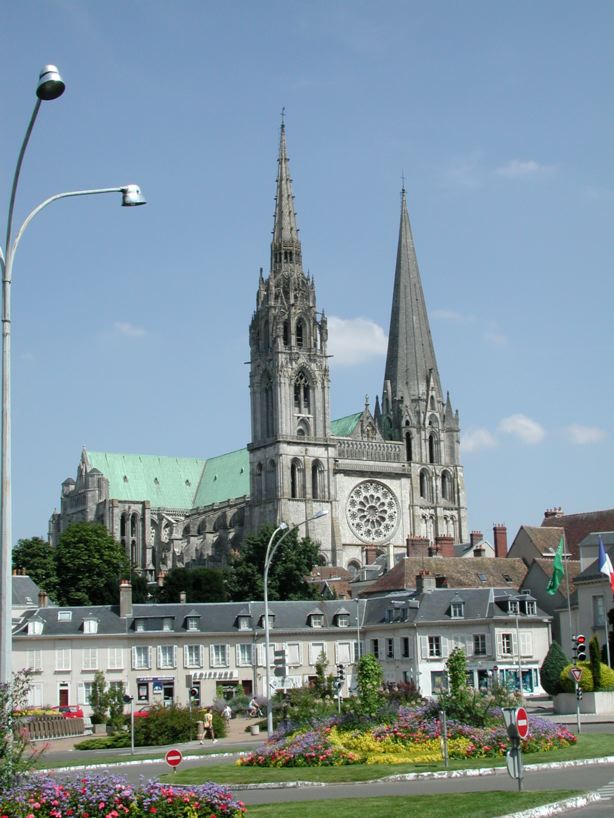 We
were getting tired of the Paris heat, although there were signs that the
weather pattern was breaking up a bit and last night wasn’t nearly as hot
and stuffy as the previous night had been. Chartres is a great day trip
from Paris, only about 45 minutes away on the train. I had been there 17
years ago and remembered fondly the tour of the magnificent cathedral I had
taken from a British chap who had been there forever, as I recalled.
We
were getting tired of the Paris heat, although there were signs that the
weather pattern was breaking up a bit and last night wasn’t nearly as hot
and stuffy as the previous night had been. Chartres is a great day trip
from Paris, only about 45 minutes away on the train. I had been there 17
years ago and remembered fondly the tour of the magnificent cathedral I had
taken from a British chap who had been there forever, as I recalled.
With our usual impeccable sense of timing, we arrived at the Gare de
Montparnasse with about 5 minutes to buy our ticket if we didn’t want to
wait for a train. Once again I did battle with the automatic ticket
machines, with about as much skill as I had mustered before, sadly. We ran
to the train and made it aboard, although I forgot to « composter »
the train ticket in the dash to the train. Not a problem, said the
conductor, as he manually stamped us aboard while the train pulled away. We
started French lessons orally in our comfy compartment at the rear of the
train, working on question and answer to get the boys posing questions and
answering them. Things were going pretty well, with most answers actually
referring to the questions being asked! After about the third stop the
conductor made a modest announcement to the effect that the last three cars
were not quite making into the stations; now, we were of course lodged in
the very last car in view of our late arrival, so we were not able to see
what station we were not stopping in. After awhile, this became unnerving
and we migrated forward in the train in hopes of not missing our stop.
This put a damper on the French practice, but we spotted the cathedral spires
in time to gather up our stuff and jump off the train at Chartres station.

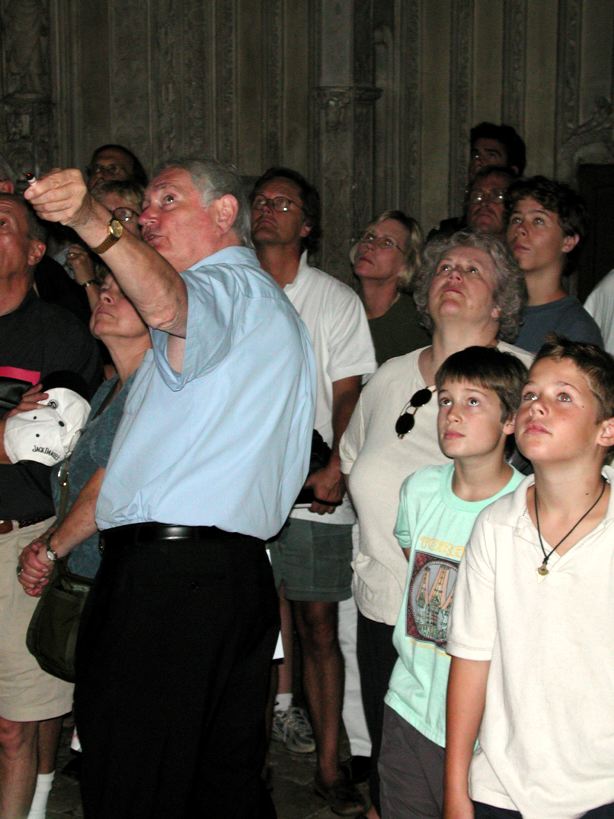 Chartres cathedral has the best-preserved set of stained glass windows of
any gothic cathedral in France and suffered only modest damage during the
French Revolution, as compared to the extensive damage wrought to Notre
Dame de Paris by the angry mobs. Chartres cathedral is dedicated to the
Virgin Mary and houses a relic believed to be a garment Mary wore when she
gave birth to Jesus. This was given to an older version of the present
cathedral in 876 by Charles the Bald. He was the grandson of Charlemagne,
who had been given the relic as a gift from the Empress Irene of
Byzantium. The relic ensured that many pilgrims visited the cathedral at
Chartres over the centuries, and led successive generations of the
cathedral to be large enough to accommodate the great number of visitors.
The present (fifth) cathedral was constructed rapidly (in a span of about
30 years after a fire destroyed much of the fourth cathedral in 1194. The
plain, geometric right spire survives from the Romanesque fourth cathedral;
the high gothic left spire was added in the 15th century.
Chartres cathedral has the best-preserved set of stained glass windows of
any gothic cathedral in France and suffered only modest damage during the
French Revolution, as compared to the extensive damage wrought to Notre
Dame de Paris by the angry mobs. Chartres cathedral is dedicated to the
Virgin Mary and houses a relic believed to be a garment Mary wore when she
gave birth to Jesus. This was given to an older version of the present
cathedral in 876 by Charles the Bald. He was the grandson of Charlemagne,
who had been given the relic as a gift from the Empress Irene of
Byzantium. The relic ensured that many pilgrims visited the cathedral at
Chartres over the centuries, and led successive generations of the
cathedral to be large enough to accommodate the great number of visitors.
The present (fifth) cathedral was constructed rapidly (in a span of about
30 years after a fire destroyed much of the fourth cathedral in 1194. The
plain, geometric right spire survives from the Romanesque fourth cathedral;
the high gothic left spire was added in the 15th century.
We knew that Malcom Miller was still giving tours as of 1999, according to
our slightly old version of Let’s Go, and we were hopeful that
he was still giving tours at noon. Sure enough, he is still going strong
and we had only a 15-minute wait before the tour was to start. According
to the posted sign, tours required at least 12 visitors to make it a go;
fortunately, we weren’t close, although he claims that in the peak season
the groups can get much larger. He also explained that he has modified his
way of charging for his services; he used to ask for money at the end of
the tour, but found that many people seemed to evaporate just at the end.
Now, he requests 50 FF up front, and kids are free. No mercy for senior
citizens, however, as he is one himself and earns his own living.
 The tour included some of the history and his reading for us a few of the
windows. For us heathens, most of the biblical history was unfamiliar but
the story of the building of the cathedral in record time following the
fire, the great sponsorship by local craftsmen and guild members,
memorialized by their panes at the bottom of the great stained glass
window each sponsored, and the discussions of restoration efforts were
quite interesting. The window on the left has been restored to remove
centuries of pigeon droppings, dirt, grime, and “oxidation”; the one on the
right awaits restoration. The difference is dazzling. After they began
with the upper window on the left, they changed their minds and decided to
restore the lower windows first. An example is the window comparing the
ancient zodiac with Christian festivals and months, shown above left.
The tour included some of the history and his reading for us a few of the
windows. For us heathens, most of the biblical history was unfamiliar but
the story of the building of the cathedral in record time following the
fire, the great sponsorship by local craftsmen and guild members,
memorialized by their panes at the bottom of the great stained glass
window each sponsored, and the discussions of restoration efforts were
quite interesting. The window on the left has been restored to remove
centuries of pigeon droppings, dirt, grime, and “oxidation”; the one on the
right awaits restoration. The difference is dazzling. After they began
with the upper window on the left, they changed their minds and decided to
restore the lower windows first. An example is the window comparing the
ancient zodiac with Christian festivals and months, shown above left.
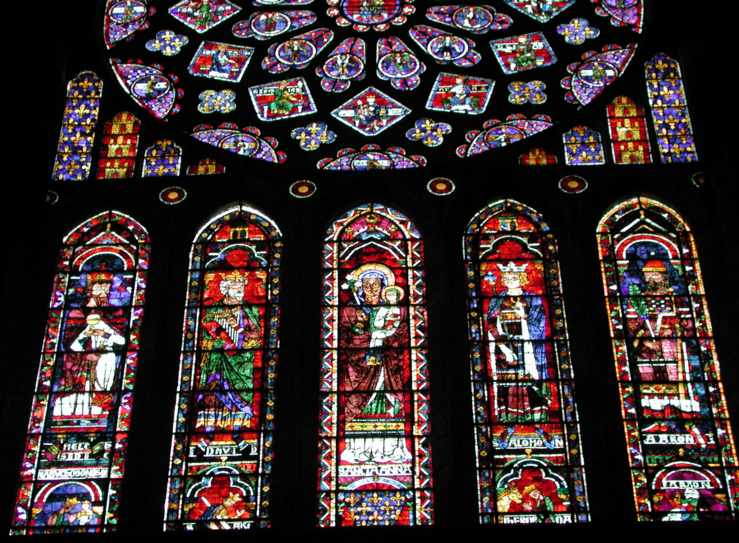
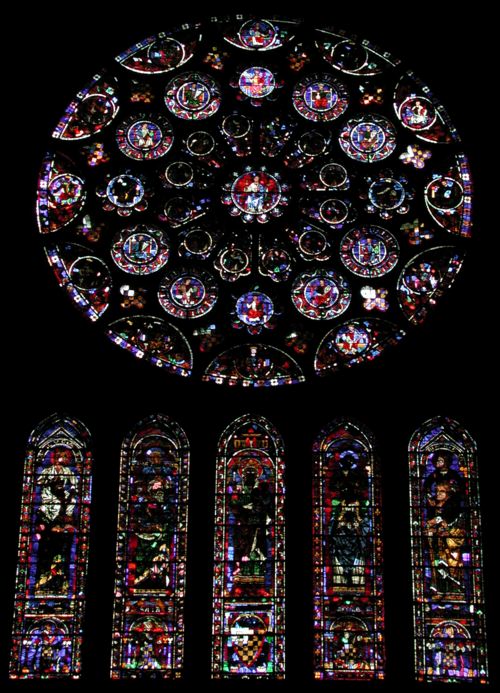 The great rose windows provide another example of the dramatic change in
affect brought about by restoration. The north rose on the left has been
restored; the south rose has not. Even though the sun was in the south, the
north rose is much brighter and more vivid.
The great rose windows provide another example of the dramatic change in
affect brought about by restoration. The north rose on the left has been
restored; the south rose has not. Even though the sun was in the south, the
north rose is much brighter and more vivid.
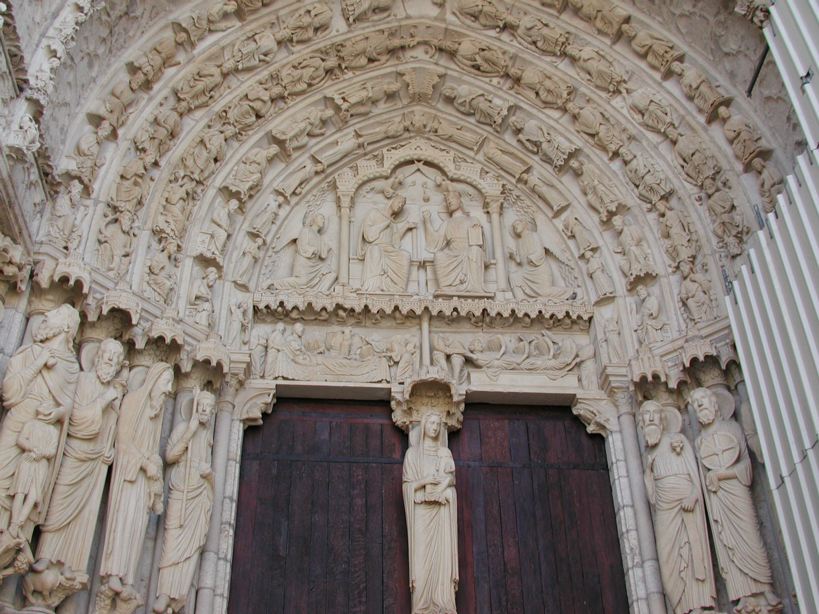
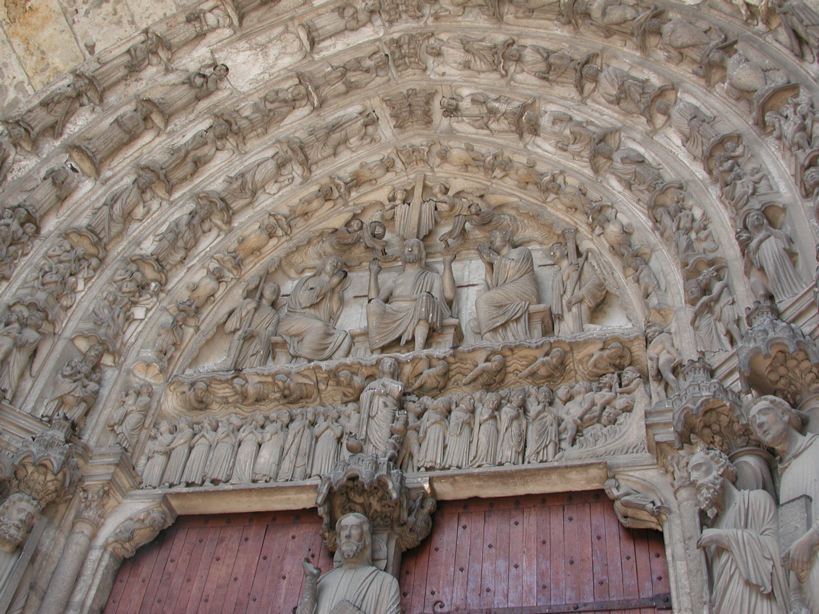 The statuary outside is also being restored, although this appears to be a
much more preliminary effort. The statuary and carvings around the door on
the left have been restored, whereas those on the right have not.
When the layers of crud are removed, the pale
yellow color of the native stone comes out beautifully. However, this is
not how the door would have looked in the Middle Ages; all the statuary
was painted. Evidently, with appropriate viewing equipment the folks
engaged in the restoration effort can see vestiges of the paint beneath the
grime, including irises and pupils in the eyeballs of the figures.
The statuary outside is also being restored, although this appears to be a
much more preliminary effort. The statuary and carvings around the door on
the left have been restored, whereas those on the right have not.
When the layers of crud are removed, the pale
yellow color of the native stone comes out beautifully. However, this is
not how the door would have looked in the Middle Ages; all the statuary
was painted. Evidently, with appropriate viewing equipment the folks
engaged in the restoration effort can see vestiges of the paint beneath the
grime, including irises and pupils in the eyeballs of the figures.
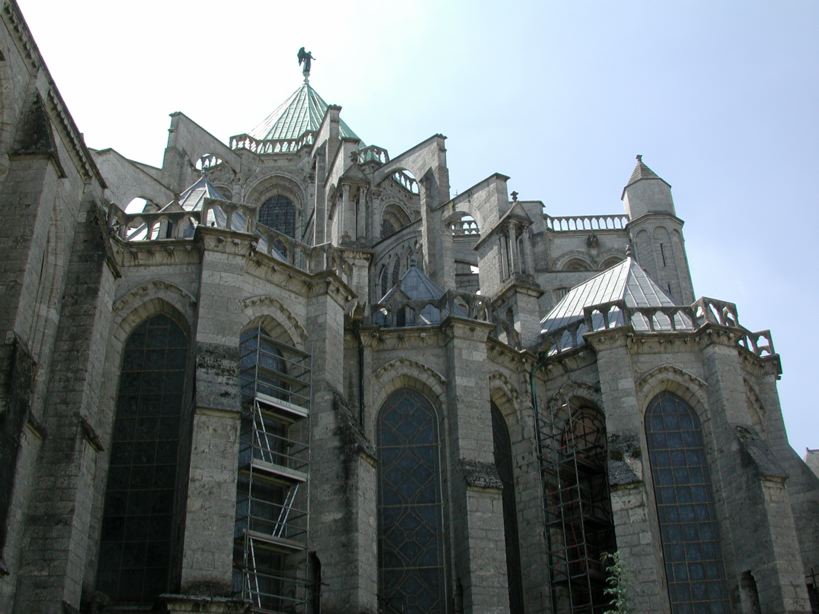 Chartres is a wonder, especially on the inside. It is a very large
cathedral and the windows are truly amazing, especially after they have
been restored. Incredibly, all the windows were removed from the cathedral
during both world wars, in 1918 and in 1940, when half of them were shipped
to southern France. Fortunately, no damage befell the building during
either war, nor any of the windows during these nerve-wracking dismounting
and remounting procedures.
Chartres is a wonder, especially on the inside. It is a very large
cathedral and the windows are truly amazing, especially after they have
been restored. Incredibly, all the windows were removed from the cathedral
during both world wars, in 1918 and in 1940, when half of them were shipped
to southern France. Fortunately, no damage befell the building during
either war, nor any of the windows during these nerve-wracking dismounting
and remounting procedures.
The outside of the church is heavier and plainer than either Notre Dame
de Paris or Notre Dame de Strasbourg, although evidently much more uniform
in period (early 13th century) due to the rapid construction of the fifth
cathedral on the significant remains of fourth. I asked Malcolm in the
afternoon why Chartres did not seem to have gargoyles like Notre Dame de
Paris, to which he seemed to take offense. Chartres does have gargoyles
(“gargoyle, gargle, gurgle, all the same word”), which are waterspouts to
keep the run off away from the foundation. What it doesn’t have are
grotesques, which are abundant in Paris. These, however, are 19th
century. I guess they were inspired by the French Revolution.
After lunch behind the church, the boys needed to run around a bit. I stole
away to wander all around the outside, and then back in to look at some of
the interior sculpture and more of the stained glass windows. Without
Malcolm’s talking through the panels of the windows, and with the
darker and less clear unrestored windows, I was happy enough to go along
with the suggestion that we needed to find a café for some beers and sodas
before our train ride back.
Three beers later, we still didn’t want to go home to hot Paris, so we
went across the street to the movies to see Eddie Murphy in Doctor
Doolittle II, en français, bien sûr! Linda and I found this
much easier to understand than Shrek and the kids enjoyed it pretty well.
After that, it wasn’t long before we caught a train back to Paris.
|
This page was last modified on Sun, Aug 19, 2001.
|
 We
were getting tired of the Paris heat, although there were signs that the
weather pattern was breaking up a bit and last night wasn’t nearly as hot
and stuffy as the previous night had been. Chartres is a great day trip
from Paris, only about 45 minutes away on the train. I had been there 17
years ago and remembered fondly the tour of the magnificent cathedral I had
taken from a British chap who had been there forever, as I recalled.
We
were getting tired of the Paris heat, although there were signs that the
weather pattern was breaking up a bit and last night wasn’t nearly as hot
and stuffy as the previous night had been. Chartres is a great day trip
from Paris, only about 45 minutes away on the train. I had been there 17
years ago and remembered fondly the tour of the magnificent cathedral I had
taken from a British chap who had been there forever, as I recalled.
 Chartres cathedral has the best-preserved set of stained glass windows of
any gothic cathedral in France and suffered only modest damage during the
French Revolution, as compared to the extensive damage wrought to Notre
Dame de Paris by the angry mobs. Chartres cathedral is dedicated to the
Virgin Mary and houses a relic believed to be a garment Mary wore when she
gave birth to Jesus. This was given to an older version of the present
cathedral in 876 by Charles the Bald. He was the grandson of Charlemagne,
who had been given the relic as a gift from the Empress Irene of
Byzantium. The relic ensured that many pilgrims visited the cathedral at
Chartres over the centuries, and led successive generations of the
cathedral to be large enough to accommodate the great number of visitors.
The present (fifth) cathedral was constructed rapidly (in a span of about
30 years after a fire destroyed much of the fourth cathedral in 1194. The
plain, geometric right spire survives from the Romanesque fourth cathedral;
the high gothic left spire was added in the 15th century.
Chartres cathedral has the best-preserved set of stained glass windows of
any gothic cathedral in France and suffered only modest damage during the
French Revolution, as compared to the extensive damage wrought to Notre
Dame de Paris by the angry mobs. Chartres cathedral is dedicated to the
Virgin Mary and houses a relic believed to be a garment Mary wore when she
gave birth to Jesus. This was given to an older version of the present
cathedral in 876 by Charles the Bald. He was the grandson of Charlemagne,
who had been given the relic as a gift from the Empress Irene of
Byzantium. The relic ensured that many pilgrims visited the cathedral at
Chartres over the centuries, and led successive generations of the
cathedral to be large enough to accommodate the great number of visitors.
The present (fifth) cathedral was constructed rapidly (in a span of about
30 years after a fire destroyed much of the fourth cathedral in 1194. The
plain, geometric right spire survives from the Romanesque fourth cathedral;
the high gothic left spire was added in the 15th century. The tour included some of the history and his reading for us a few of the
windows. For us heathens, most of the biblical history was unfamiliar but
the story of the building of the cathedral in record time following the
fire, the great sponsorship by local craftsmen and guild members,
memorialized by their panes at the bottom of the great stained glass
window each sponsored, and the discussions of restoration efforts were
quite interesting. The window on the left has been restored to remove
centuries of pigeon droppings, dirt, grime, and “oxidation”; the one on the
right awaits restoration. The difference is dazzling. After they began
with the upper window on the left, they changed their minds and decided to
restore the lower windows first. An example is the window comparing the
ancient zodiac with Christian festivals and months, shown above left.
The tour included some of the history and his reading for us a few of the
windows. For us heathens, most of the biblical history was unfamiliar but
the story of the building of the cathedral in record time following the
fire, the great sponsorship by local craftsmen and guild members,
memorialized by their panes at the bottom of the great stained glass
window each sponsored, and the discussions of restoration efforts were
quite interesting. The window on the left has been restored to remove
centuries of pigeon droppings, dirt, grime, and “oxidation”; the one on the
right awaits restoration. The difference is dazzling. After they began
with the upper window on the left, they changed their minds and decided to
restore the lower windows first. An example is the window comparing the
ancient zodiac with Christian festivals and months, shown above left.
 The great rose windows provide another example of the dramatic change in
affect brought about by restoration. The north rose on the left has been
restored; the south rose has not. Even though the sun was in the south, the
north rose is much brighter and more vivid.
The great rose windows provide another example of the dramatic change in
affect brought about by restoration. The north rose on the left has been
restored; the south rose has not. Even though the sun was in the south, the
north rose is much brighter and more vivid. 
 The statuary outside is also being restored, although this appears to be a
much more preliminary effort. The statuary and carvings around the door on
the left have been restored, whereas those on the right have not.
When the layers of crud are removed, the pale
yellow color of the native stone comes out beautifully. However, this is
not how the door would have looked in the Middle Ages; all the statuary
was painted. Evidently, with appropriate viewing equipment the folks
engaged in the restoration effort can see vestiges of the paint beneath the
grime, including irises and pupils in the eyeballs of the figures.
The statuary outside is also being restored, although this appears to be a
much more preliminary effort. The statuary and carvings around the door on
the left have been restored, whereas those on the right have not.
When the layers of crud are removed, the pale
yellow color of the native stone comes out beautifully. However, this is
not how the door would have looked in the Middle Ages; all the statuary
was painted. Evidently, with appropriate viewing equipment the folks
engaged in the restoration effort can see vestiges of the paint beneath the
grime, including irises and pupils in the eyeballs of the figures. Chartres is a wonder, especially on the inside. It is a very large
cathedral and the windows are truly amazing, especially after they have
been restored. Incredibly, all the windows were removed from the cathedral
during both world wars, in 1918 and in 1940, when half of them were shipped
to southern France. Fortunately, no damage befell the building during
either war, nor any of the windows during these nerve-wracking dismounting
and remounting procedures.
Chartres is a wonder, especially on the inside. It is a very large
cathedral and the windows are truly amazing, especially after they have
been restored. Incredibly, all the windows were removed from the cathedral
during both world wars, in 1918 and in 1940, when half of them were shipped
to southern France. Fortunately, no damage befell the building during
either war, nor any of the windows during these nerve-wracking dismounting
and remounting procedures.